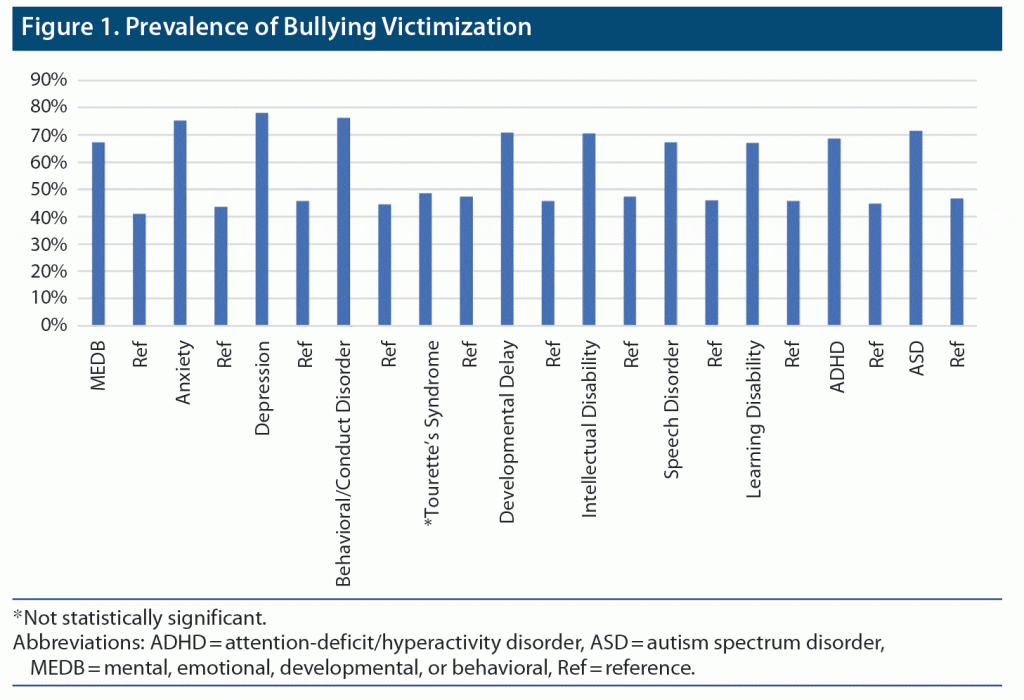Bullying victimization among children remains a pervasive problem. Bullying victimization can make it difficult for children with psychiatric problems to cope and might result in worsened outcomes.1,2 Bullying victimization in children is associated with increased risk of anxiety, depression, sleep difficulties, lower academic achievement, and dropping out of school.3 We hypothesized that vulnerable children with mental, emotional, developmental, or behavioral (MEDB) problems may be at increased risk of bullying victimization. Thus, we aim to identify the prevalence and odds of bullying victimization among US children with 1 or more MEDB problems compared to children without.
METHODS
A retrospective analysis of the National Survey of Children’s Health 2018–2019 data was performed. Children (aged 3–17 years) with current MEDB and bullying victimization occurrences within the past 12 months were identified using the survey questionnaire. The MEDB measure was derived based on 10 conditions: Tourette syndrome, anxiety problems, depression, behavioral and conduct problems, developmental delay, intellectual disability, speech or other language disorder, learning disability, autism spectrum disorder, and attention-deficit/hyperactivity disorder. Univariate analysis and multivariable survey logistic regression analysis were performed to identify the prevalence and odds of bullying victimization among children with MEDB issues. A complex survey analysis method was used, and weights were applied for national estimates.
RESULTS
A total of 61,714,478 participants were included, of which 22.1% reported ≥ 1 current MEDB problems. Compared to participants with no MEDB issues, the prevalence of being bullied ≥ 1 time was significantly higher in those with ≥ 1 current MEDB problems (67.3% vs 41.1%, P < .0001). Figure 1 shows the prevalence of bullying victimization among those with MEDB issues. Additionally, in comparison to those without, a higher percentage of children with ≥ 1 MEDB problem were bullied almost every day (5.3% vs 0.8%, P < .0001). In regression analysis, after adjusting for age, sex, race, socioeconomic status, and overall health status, children with ≥ 1 MEDB issue were at higher odds of bullying victimization (adjusted odds ratio = 3.2; 95% CI, 2.8–3.5; P < .0001) than those without.
DISCUSSION
Children with MEDB problems are at higher odds of bullying victimization. Additionally, children with MEDB problems experience a higher intensity of bullying victimization (almost every day as per the results of our study). Our results are consistent with other studies, which showed that children with ≥ 1 MEDB issue are at a high risk of being bullied.4,5 The results of our study highlight the need for specialized interventions to reduce bullying victimization among the vulnerable pediatric populations with MEDB problems. Children with MEDB problems may already have special educational needs. Bullying victimization among these vulnerable children might increase school abstinence, worsen mental health outcomes, and have an additive effect on poor educational outcomes.1,2 Antibullying interventions should be implemented with a multitier approach, which should include programs that target creating awareness, involving parents, enforcing policies, modeling the desirable behavior, and training teachers. A study by Gaffney et al6 found a larger effect size for school-bullying victimization outcomes when intervention components such as creating awareness among parents and peer involvement were implemented. We encourage further investigations to identify risk factors associated with bullying victimization among children with MEDB issues and targeted interventions to reduce bullying victimization.
The strength of our study is that it utilizes nationally representative data with a large sample size, thus improving the generalizability of our results. The limitation of our study is that it is based on a cross-sectional design, indicating association but not causation. Additionally, the clinical conditions were based on parents’ responses to survey questions and not on medical records.
Article Information
Published Online: July 6, 2023. https://doi.org/10.4088/PCC.22br03406
© 2023 Physicians Postgraduate Press, Inc.
Prim Care Companion CNS Disord. 2023;25(4):22br03406
Submitted: August 28, 2022; accepted November 14, 2022.
To Cite: Desai S, Vadukapuram R, Trivedi C, et al. Bullying victimization among children with mental, emotional, developmental, or behavioral problems: a US population-based study. Prim Care Companion CNS Disord. 2023;25(4):22br03406.
Author Affiliations: Department of Psychiatry, Tower Health/Phoenixville Hospital, Phoenixville, Pennsylvania (Desai); Department of Psychiatry, The University of Texas Rio Grande Valley, Harlingen (Vadukapuram); Department of Psychiatry, Texas Tech University Health Science Center at Odessa/Permian Basin, Odessa (Trivedi); Department of Psychiatry, Father Muller Medical College, Karnataka, India (Xavier); Department of Psychiatry, Boston Children’s Hospital/Harvard Medical School, Boston, Massachusetts (Mansuri).
Corresponding Author: Saral Desai, MD, Tower Health/Phoenixville Hospital, 1427 Vine St, Philadelphia, PA 19102 ([email protected]).
Relevant Financial Relationships: None.
Funding source/support: None.
References (6)

- Vidourek RA, King KA, Merianos AL. School bullying and student trauma: fear and avoidance associated with victimization. J Prev Interv Community. 2016;44(2):121–129. PubMed CrossRef
- Bitsika V, Heyne DA, Sharpley CF. Is bullying associated with emerging school refusal in autistic boys? J Autism Dev Disord. 2021;51(4):1081–1092. PubMed CrossRef
- Centers for Disease Control and Prevention. Violence Prevention. Fast Fact: Preventing Bullying. Accessed August 27, 2022. https://www.cdc.gov/violenceprevention/youthviolence/bullyingresearch/fastfact.html
- Charania SN, Danielson ML, Claussen AH, et al. Bullying victimization and perpetration among US children with and without tourette syndrome. J Dev Behav Pediatr. 2022;43(1):23–31. PubMed CrossRef
- Halabi F, Ghandour L, Dib R, et al. Correlates of bullying and its relationship with psychiatric disorders in Lebanese adolescents. Psychiatry Res. 2018;261:94–101. PubMed CrossRef
- Gaffney H, Ttofi MM, Farrington DP. What works in anti-bullying programs? analysis of effective intervention components. J Sch Psychol. 2021;85:37–56. PubMed CrossRef
Please sign in or purchase this PDF for $40.




